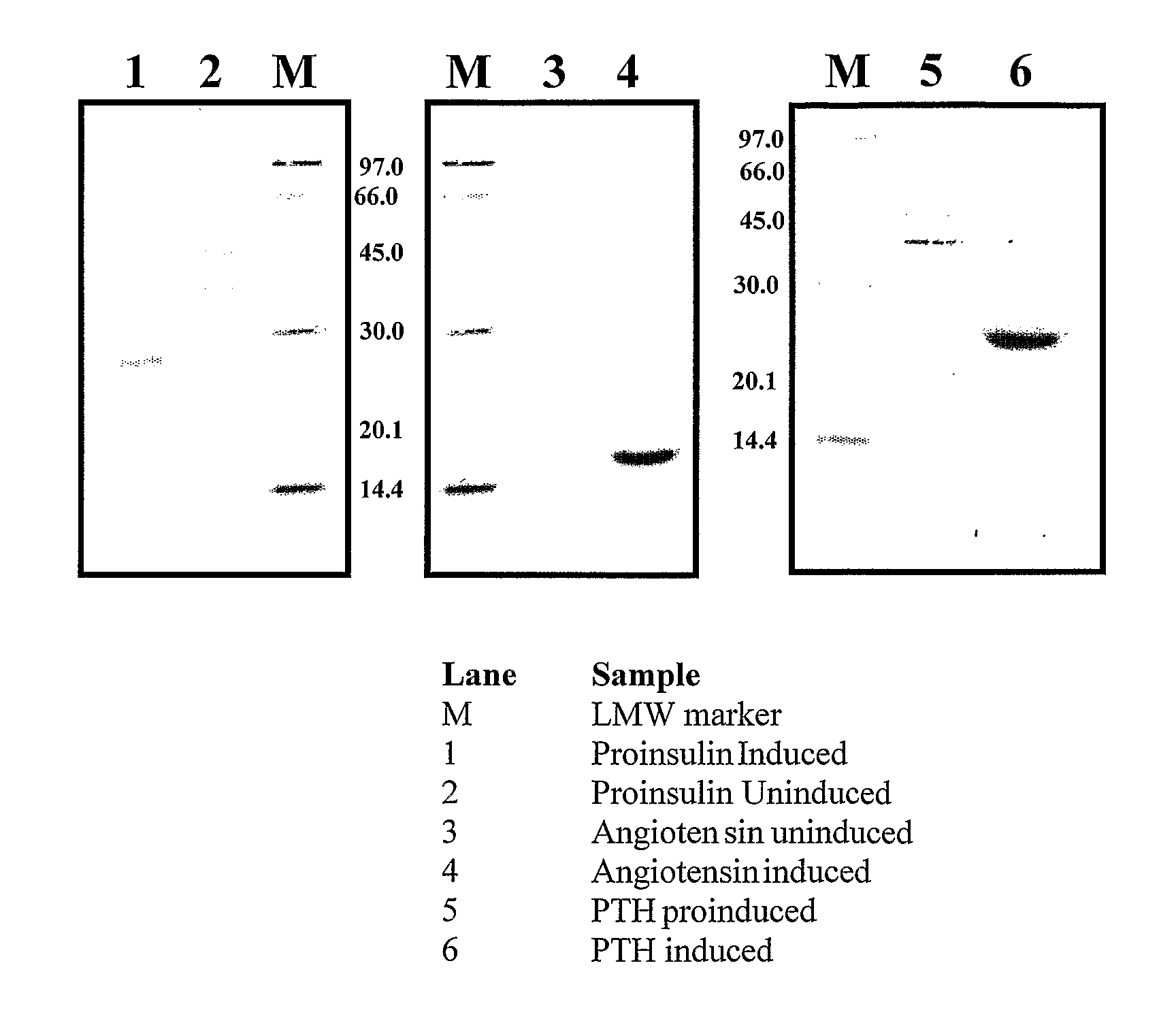Process for the expression of peptides of interest using GCSF as a fusion partner
a technology of gcsf and peptides, which is applied in the field of recombinant peptide production, can solve the problems of limiting the commercialization of peptides as therapeutics, affecting the commercial scalability, and inefficient cos
- Summary
- Abstract
- Description
- Claims
- Application Information
AI Technical Summary
Benefits of technology
Problems solved by technology
Method used
Image
Examples
example 1
Construction of GCSF Expression Vector
[0044]Human placental total RNA (Clontech) was used as a template for reverse transcriptase-polymerase chain reaction (RT-PCR) based cloning of the desired GCSF (174 amino acid variant) gene sequence. PCR was performed using a pair of gene specific oligonucleotide primers (SEQ ID NO:3 and SEQ ID NO:4). The oligonucleotides also contained the cloning sites and the start codon for Methionine, and were designed to modify the 5′ end of the gene such that the GC content of the 5′ region was reduced without affecting the amino acid sequence and the optimized codons were also efficiently used by E. coli. Seven codons were modified at 5′ end. Double stranded cDNA was synthesized from Human placental total RNA using MMLV reverse transcriptase (MBI Fermentas, USA) by gene specific priming [Maniatis et al., Molecular cloning; A Laboratory Manual (Cold Spring harbor Laboratory Press, Cold Spring Harbor, N.Y.), (1990)]. This cDNA was then subjected to 40 cyc...
example 2
Construction of PTH Fusion Protein Expression Vector.
[0045]Human GCSF gene was PCR amplified from pET27b(+)-GCSF-1 plasmid vector prepared earlier, using a set of oligonucleotide primers where the forward primer contained the restriction site Nde I (SEQ ID NO:3), and reverse primer contained a BamHI restriction enzyme site (SEQ ID NO:51. This amplified PCR product was cleaned using Gel extraction Kit (Qiagen) and was digested with Nde I and Bam HI restriction endonucleases. The digested PCR product was further purified using Gel Extraction kit (Qiagen).
[0046]Human Parathyroid Hormone (1-34) gene was synthesised using two complementary oligonucleotides (SEQ ID NO:8 and SEQ ID NO:9) corresponding to the coding and anti-coding strand of the Human Parathyroid Hormone (1-34) gene. Equimolar concentrations of both the oligonucleoties were heated in a Thermal Cycler at 95 degree celcius for 5 minutes and then allowed to anneal by cooling at room temperature for an hour. The annealed oligon...
example 3
Construction of Proinsulin Fusion Protein Expression Vector
[0049]Human pancreatic total RNA (Clontech) was used as a template for reverse transcriptase-polymerase chain reaction (RT-PCR) based cloning of the desired proinsulin gene sequence. PCR was performed using a pair of gene specific oligonucleotide forward and reverse primers (SEQ ID NO:14 and SEQ ID NO:15) corresponding to the coding region of the Proinsulin gene (SEQ ID NO:12 and SEQ ID NO:13). Double stranded cDNA was synthesized from Human placental total RNA using MMLV reverse transcriptase (MBI Fermentas, USA) by gene specific priming [Maniatis et al., Molecular cloning; A Laboratory Manual (Cold Spring harbor Laboratory Press, Cold Spring Harbor, N.Y.), (1990)]. This cDNA was then subjected to 40 cycles of PCR amplification using 100 picomoles of gene specific oligonucleotide primers in a volume of 100 μl containing 50 mM Tris-Cl (pH8.3), 2.5 mM MgCl2, 200 μM each of the 4 dNTPs and 2.5 units of Pfu Polymerase. Each PCR...
PUM
| Property | Measurement | Unit |
|---|---|---|
| temperature | aaaaa | aaaaa |
| volume | aaaaa | aaaaa |
| length | aaaaa | aaaaa |
Abstract
Description
Claims
Application Information
 Login to View More
Login to View More - R&D
- Intellectual Property
- Life Sciences
- Materials
- Tech Scout
- Unparalleled Data Quality
- Higher Quality Content
- 60% Fewer Hallucinations
Browse by: Latest US Patents, China's latest patents, Technical Efficacy Thesaurus, Application Domain, Technology Topic, Popular Technical Reports.
© 2025 PatSnap. All rights reserved.Legal|Privacy policy|Modern Slavery Act Transparency Statement|Sitemap|About US| Contact US: help@patsnap.com

